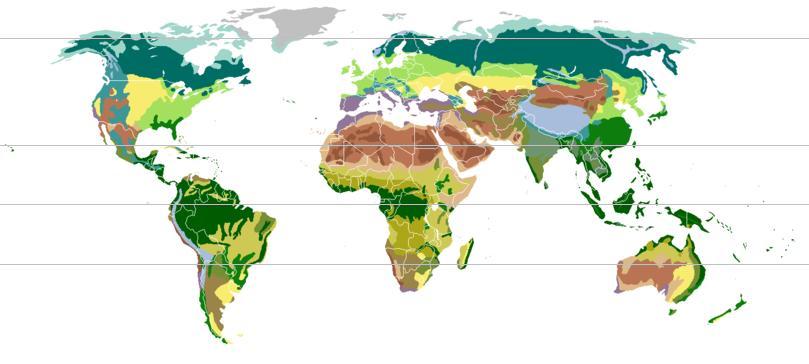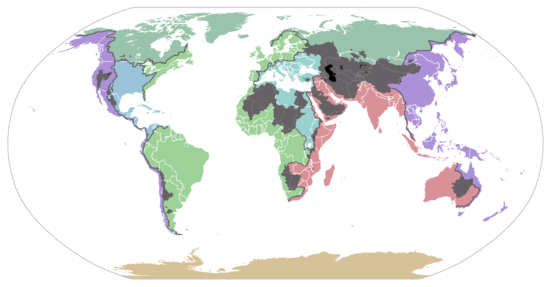حيوم
الحيوم أو البيوم Biome هي نمط معين من المجموعات البيئية (الإقليمية) الرئيسية المتشابهة من مجتمعات النبات والحيوان وعضيات التربة المميزة.
البايوم أو النطاق الإحيائي مجموعة نباتات وحيوانات تغطي منطقة جغرافية واسعة. تحدَّد حدود البايومات المختلفة في الأرض بشكل رئيسيّ بوساطة المناخ. وتشمل أراضي البايومات المهمة: 1- التندرا. 2- الغابات الصنوبرية. 3- الغابات النفضية. 4- المراعي . 5- السافانا. 6- الصحاري. 7- الأراضي ذات الأشجار الخفيضة. 8- غابات الأمطار الاستوائية (المدارية).
ويميزُ معظم خبراء علم البيئة بين بايوم الغابة الصنوبرية المعتدلة، وبايوم الغابة الصنوبرية الشمالية، وتُعْرَف أيضًا ببايوم الغابة الشمالية أو بايوم غابة التبغة أي غابة صنوبر سَبخة. ولايمكن تحديد البايومات المائية بسهولة.
يتميَّزُ كل بايوم بوجود أنواع ذات صفات مميزة من النباتات والحيوانات وبمناخها الخاص. ويكون مناخُ الغابات الصنوبرية الشمالية على سبيل المثال قاسيًا وذاشتاء باردٍ طويلٍ وصيف قصير. تكون النباتات الرئيسية في هذا البايوم من الأشجار حاملات الصنوبر دائمة الخضرة، مثل الأشجار الراتينجية، والتنوب والصنوبر. ومن الحيوانات آكلة النباتات المهيمنة هنا الموظ وأيائل أخرى. وتشمل نفسُ البايوم مجموعات متشابهة تُوجد في أجزاء مختلفة من العالم. تشْمل، مثلاً، بايوم المراعي سهول الإستبس (السهول الخالية من الشجر) في آسيا، وسهولاً ونجودًا جرداء في أمريكا الشمالية ومروجًا في إفريقيا الجنوبية وسهول البامبا المعْشَوْشبة المترامية الأطراف في أمريكا الجنوبية. وقد تختلف صنوف الأعشاب في كل من هذه الأقاليم، بينما تشترك كل هذه المناطق في نفس النمط من الحياة النباتية.
تُحدّدُ الطرقُ التي تتفاعل بها النباتات مع الحيوانات بعضها مع البعض الآخر في بايوم البيئة الملائمة فيها. فالبيئة الملائمة هي عمل وعنوان العلاقات بين الكائنات الحيّة وبيئتها للنبات والحيوان في الطبيعة. فيشير العمل إلى وظيفة النبات أو الحيوان، والعنوان يشير إلى الموطن. ويكون الرعي مثلاً الوظيفة الرئيسية للعديد من الحيوانات في بايوم المراعي. لقد كان الجاموس الأمريكي البيسون فيما مضى المهيمن على المراعي في أمريكا الشمالية، بينما تملأ أنواع متعددة من الغزلان والظباء معًا المراعي الإفريقية، وتُدْعى النباتاتُ أو الحيوانات التي تملأ البيئة الملائمة في الأماكن المختلفة، مثل الجاموس الأمريكي في أمريكا الشمالية، والغزلان في إفريقيا، بـ التكافؤ البيئي.
وقد سهَّلت صفات معينة على بعض الحيوانات التكيف للحياة في البايوم الخاص بها. يوجد مثلاً في بايوم الصحراء الصبّار وله سيقان لحمية لخزن الماء، وأشواك تساعد على حمايته من الحيوانات آكلة النباتات في الصحراء. بينما تكون بعض الحيوانات التي تعيش في التندرا بيضاء اللون في الشتاء وبُنّية في الصيف؛ لتنسجم ألوانها مع الثلج في الشتاء والحياة النباتية في الصيف.
. . . . . . . . . . . . . . . . . . . . . . . . . . . . . . . . . . . . . . . . . . . . . . . . . . . . . . . . . . . . . . . . . . . . . . . . . . . . . . . . . . . . . . . . . . . . . . . . . . . . . . . . . . . . . . . . . . . . . . . . . . . . . . . . . . . . . . . . . . . . . . . . . . . . . . . . . . . . . . . . . . . . . . . .
نظام اودڤاري Udvardy System
In 1975, Miklos Udvardy published a system of biogeographic provinces that were divided into 12 terrestrial biomes:
- Tropical humid forests
- Subtropical and temperate rainforests or woodlands
- Temperate broad-leaf forests or woodlands and subpolar deciduous thickets
- Temperate needle-leaf forests or woodlands
- Evergreen sclerophyllous forests, scrub, or woodlands
- Tropical dry or deciduous forests (including Monsoon forests) or woodlands
- Temperate grasslands
- Warm deserts and semideserts
- Cold-winter (continental) deserts and semideserts
- Tundra communities and barren Arctic deserts
- Mixed mountain and highland systems with complex zonation
- Mixed island systems
نظام بيلي Bailey System
Robert G. Bailey developed a biogeographical classification system for the United States in a map published in 1975. Bailey subsequently expanded the system to include the rest of North America in 1981, and the world in 1989. The Bailey system is based on climate, and is divided into four domains (Polar, Humid Temperate, Dry, and Humid Tropical), with further divisions based on other climate characteristics (subarctic, warm temperate, hot temperate, and subtropical, marine and continental, lowland and mountain).
- 100 النطاق القطبي
- 120 Tundra Division
- M120 Tundra Division - Mountain Provinces
- 130 Subarctic Division
- M130 Subarctic Division - Mountain Provinces
- 200 Humid Temperate Domain
- 210 Warm Continental Division
- M210 Warm Continental Division - Mountain Provinces
- 220 Hot Continental Division
- M220 Hot Continental Division - Mountain Provinces
- 230 Subtropical Division
- M230 Subtropical Division - Mountain Provinces
- 240 Marine Division
- M240 Marine Division - Mountain Provinces
- 250 Prairie Division
- 260 Mediterranean Division
- M260 Mediterranean Division - Mountain Provinces
- 300 Dry Domain
- 310 Tropical/Subtropical Steppe Division
- M310 Tropical/Subtropical Steppe Division - Mountain Provinces
- 320 Tropical/Subtropical Desert Division
- 330 Temperate Steppe Division
- M330 Temperate Steppe Division - Mountain Provinces
- 340 Temperate Desert Division
- M340 Temperate Desert Division - Mountain Provinces
- 400 Humid Tropical Domain
- 410 Savanna Division
- M410 Savanna Division - Mountain Provinces
- 420 Rainforest Division
- M420 Rainforest Division - Mountain Provinces
نظام صندوق الحياة البرية العالمي WWF system
A team of biologists convened by the World Wide Fund for Nature (WWF) developed an ecological land classification system that identified fourteen biomes,[1] called major habitat types, and further divided the world's land area into 867 terrestrial ecoregions. Each terrestrial Ecoregion has a specific EcoID, fomat XXnnNN (XX is the Ecozone, nn is the Biome number, NN is the individual number). This classification is used to define the Global 200 list of ecoregions identified by the WWF as priorities for conservation. The WWF major habitat types are:
- 01 Tropical and subtropical moist broadleaf forests (tropical and subtropical, humid)
- 02 Tropical and subtropical dry broadleaf forests (tropical and subtropical, semi-humid)
- 03 Tropical and subtropical coniferous forests (tropical and subtropical, semi-humid)
- 04 Temperate broadleaf and mixed forests (temperate, humid)
- 05 Temperate coniferous forests (temperate, humid to semi-humid)
- 06 Boreal forests/taiga (subarctic, humid)
- 07 Tropical and subtropical grasslands, savannas, and shrublands (tropical and subtropical, semi-arid)
- 08 Temperate grasslands, savannas, and shrublands (temperate, semi-arid)
- 09 Flooded grasslands and savannas (temperate to tropical, fresh or brackish water inundated)
- 10 Montane grasslands and shrublands (alpine or montane climate)
- 11 Tundra (Arctic)
- 12 Mediterranean forests, woodlands, and scrub or Sclerophyll forests (temperate warm, semi-humid to semi-arid with winter rainfall)
- 13 Deserts and xeric shrublands (temperate to tropical, arid)
- 14 Mangrove (subtropical and tropical, salt water inundated)
حيومات المياه العذبة
According to the World Wildlife Fund, the following are classified as freshwater biomes: [2]
|
|
Realms or Ecozones (terrestrial and freshwater, WWF)
|
|
حيومات مائية
Marine biomes (major habitat types), Global 200 (WWF)
Biomes of the coastal & continental shelf areas (Neritic zone - List of ecoregions (WWF)):
- Polar
- Temperate shelves and sea
- Temperate upwelling
- Tropical upwelling
- Tropical coral [3]
Realms or Ecozones (marine, WWF)
|
|
Other marine habitat types
- Hydrothermal vents
- Cold seeps
- Benthic zone
- Pelagic zone (trades and westerlies)
- Abyssal
- Hadal (ocean trench)
Major Habitats, Non Global 200 (WWF)
ملخص - Ecological taxonomy (WWF)
- Biosphere (List of ecoregions)
- Ecozones or Realms (8)
- Terrestrial Biomes (Major Habitat Types, 14)
- Ecoregions (867)
- Freshwater Biomes (Major Habitat Types, 12)
- Ecoregions (426)
- Terrestrial Biomes (Major Habitat Types, 14)
- Marine Ecozones or Realms (13)
- Continental Shelf Biomes (Major Habitat Types, 5)
- (Marine Provinces) (62)
- Ecoregions (232)
- (Marine Provinces) (62)
- Open & Deep Sea Biomes (Major Habitat Types)
- Continental Shelf Biomes (Major Habitat Types, 5)
- Endolithic Biome
- Ecozones or Realms (8)
حيومات أخرى
The Endolithic biome, consisting entirely of microscopic life in rock pores and cracks, kilometers beneath the surface, has only recently been discovered and does not fit well into most classification schemes.
. . . . . . . . . . . . . . . . . . . . . . . . . . . . . . . . . . . . . . . . . . . . . . . . . . . . . . . . . . . . . . . . . . . . . . . . . . . . . . . . . . . . . . . . . . . . . . . . . . . . . . . . . . . . . . . . . . . . . . . . . . . . . . . . . . . . . . . . . . . . . . . . . . . . . . . . . . . . . . . . . . . . . . . .
خرائط الحيومات

| ice sheet & polar desert tundra taiga temperate broadleaf forest | temperate steppe subtropical rainforest Mediterranean vegetation monsoon forest | صحراء قاحلة xeric shrubland dry steppe semiarid desert | ساڤانا الحشائش tree savanna subtropical dry forest tropical rainforest | تندرا جبلية montane forest |
انظر أيضاً
- Altitudinal zonation
- Biomics
- Biosphere reserve
- Earth Science
- Ecoregion
- Ecology
- Ecosystem
- Ecotope
- Ecozone
- Climate classification
- Climate zones by altitude
- Effect of Climate Change on Plant Biodiversity
- Gene pool
- Genetic pollution
- Genetic erosion
- Habitat
- Kuchler plant association
- Natural environment
- Nature
- World Network of Biosphere Reserves
المصادر
- ^ Olson, David M. et al. (2001); Terrestrial Ecoregions of the World: A New Map of Life on Earth, BioScience, Vol. 51, No. 11., pp. 933-938.
- ^ "Freshwater Ecoregions of the World: Major Habitat Types" [1]. Accessed May 12, 2008.
- ^ WWF: Marine Ecoregions of the World

